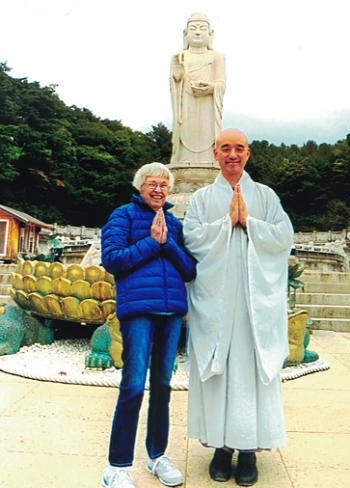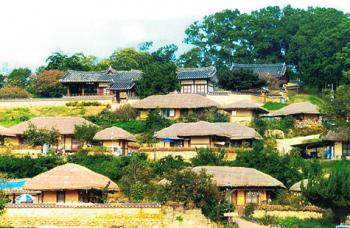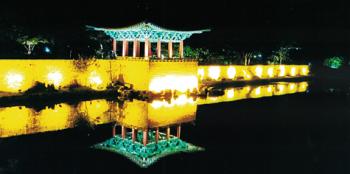South Korea with OAT
This item appears on page 30 of the May 2019 issue.
After many years of my trying to find a tour to South Korea, Overseas Adventure Travel, or OAT (Boston, MA; 800/955-1925, www.oattravel.com), finally created one. A friend and l departed in October 2017, joining OAT’s 18-day “South Korea & Japan: Temples, Shrines & Seaside Treasures” tour. We added a 6-night (with air, eight days) pre-trip to China because my friend had never been there.
The trip cost about $6,100 per person, including round-trip airfare (about $1,200) from Norfolk, Virginia, and the cost of the pre-trip to China (approximately $900). All in all, this was not an expensive trip for visiting three Asian countries, and we got to experience three very different cultures.
OAT’s tour guides in each country were outstanding. Each went out of her way to arrange different places for us to visit, allowing us to experience locations not included in the written itinerary. I want to tell you about the 9-day Korea portion.
Korea was all l had ever hoped it to be and more. After arriving in Seoul, our group spent several nights in the Pacific Hotel, located right in the center of the city’s main shopping district. And shop we did!
First, though, we spent quite some time visiting the 15th-century Changdeokgung Palace, built during the Joseon Dynasty. The palace has several interesting halls and colorful facades.
Our first lunch in Korea was at one of the restaurants serving traditional ginseng chicken soup, consisting of a chicken that’s filled with rice and floating in a bowl of broth, seasoned with ginseng. We ate outside in the garden and saw pots filled with kimchi buried in the ground.
That evening, a man who had defected from North Korea came to talk to us about his life there and his escape. This was very interesting and an added bonus to the trip. I couldn’t wait for the day we’d be traveling about 30 miles north of Seoul to the DMZ (demilitarized zone) between North and South Korea. My father had been stationed there as an advisor to the Republic of Korea Army (ROKA) in the early 1960s.
Lunch with a local family in a small village was part of a day trip to Ganghwa Island.
Then there was the day we drove from Seoul along the Han River, seeing barbed-wire fences, numerous spotlights and many guardhouses. Upon arriving at the DMZ compound, we were shown a movie about one of four tunnels the North Koreans had dug to enter South Korea. We then went down and took a tour of tunnel number three.
There was a large sign over one of the buildings: “End of Separation, Beginning of Unification.” (South Koreans often told us of their desire for a reunified Korea.) We were taken to several places to look across the Han River to North Korea, and I photographed the “Bridge of No Return.”
Again leaving from Seoul, we took a bullet train (180-plus mph) to the city of Daegu. This was the highlight of our stay in Korea because we were able to spend the night at the Donghwasa Temple, a Buddhist temple constructed in AD 493.
The monks introduced us to their proper etiquette, including how to eat dinner (no talking) and the intricacies of a tea ceremony. And one monk told us all about life in the monastery, graciously answering all of our questions.
My favorite part of our stay there was an evening walk on which I saw and heard the large ceremonial drum and bell and observed and heard the monks chanting in the main temple during evening prayers.
That night, we each slept in rooms with no furniture and only a thin pallet on the floor for a bed.
I was disappointed that we were unable to take pictures of the monk who had spoken to us, but before we left the next morning (and to my great delight), he allowed us to do so. The photograph of me standing next to the monk is my favorite picture from the entire trip.
Our last stop in Korea was the city of Gyeongju, on the East Sea (Sea of Japan). We toured the glass-paneled Gyeongju Tower, which houses the Gyeongju Seorabeol Culture Hall, filled with many artifacts from the Silla Dynasty. The city grounds are covered with many large burial mounds, several of which have been left undisturbed for centuries.
We took almost an entire day to tour the Yangdong Folk Village (AD 1433), a Joseon village with many houses over 200 years old. It was an interesting tour, and we had lunch in one of the homes.
We also visited the 6th-century Bulguksa, a Buddhist temple with two impressive (and completely different) side-by-side pagodas.
The last place we visited was the Seokguram Grotto, where there is an 11-foot statue of Buddha surrounded by his 10 disciples.
On our last night in Gyeongju, we went to the Donggung Palace and Wolji Pond. The gold-and-pastel painted pavilions and the weeping willow trees were all lit up and reflected in the water. It was a magical sight and a wonderful ending to a truly remarkable and memorable time spent in South Korea.
This is one trip to Asia l will always remember.
SANDRA YON
Virginia Beach, VA



